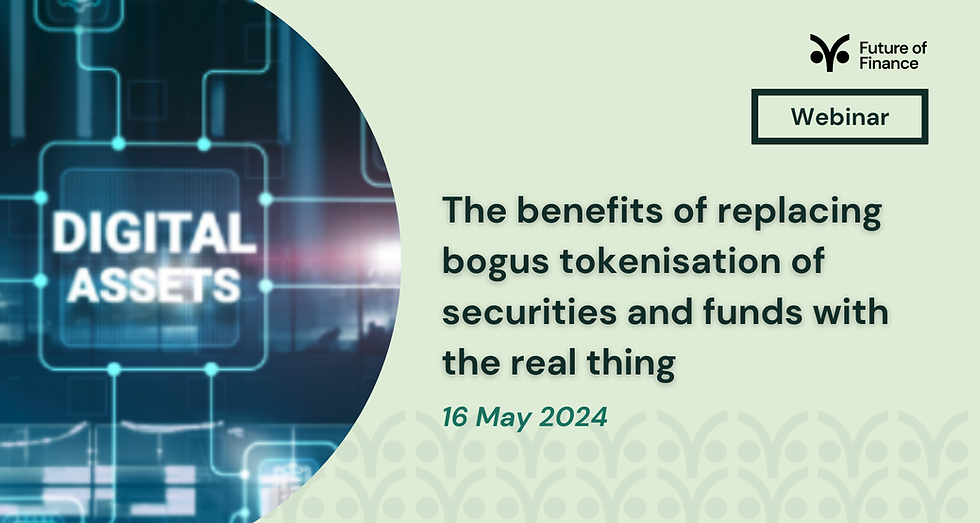The benefits of replacing bogus tokenisation of securities and funds with the real thing
- Future of Finance

- May 16, 2024
- 3 min read
Updated: Jul 23

What is the event about?
The securities and the fund markets need to be digitally transformed. The profits of the asset and wealth management industries are being squeezed by shrinking fees and rising costs. Tokenisation of both funds and the underlying securities can, properly construed, solve the problem. Unfortunately, the overwhelming majority of tokenisations of securities and funds are more like securitisations than tokenisations. Like mortgage-backed securities, they are asset-backed. Which means they are not truly digital assets at all but mere derivatives of assets which continue to exist in their traditional form, whether that is physical (as with real estate or precious metals) or digital (an oft-cited paradox is that most securities and funds exist only as digital entries in computer systems already). As a result, the medley of intermediary institutions that has developed over decades to support the traditional funds and securities industries remains undisturbed as well. This is, of course, the attraction of asset-backed tokenisation. It threatens no incumbent business with disintermediation and requires minimal changes to the existing corpus of securities and fund markets laws and regulations. But it is also the problem, because it changes next to nothing. According to SIFMA, the revenues of the global investment banking industry alone took an average of US$92.4 billion a year out of the capital markets between 2018 and 2022. But the exchanges that list securities, the brokers that execute trades on exchanges, the custodians that safekeep securities, the fund accountants that value securities, the transfer agents that maintain registers of holders of securities, the central counterparty clearing houses (CCPs) that intermediate and net trades and the central securities depositories (CSDs) that settle trades all have to be paid as well. So it is not surprising that tokenisation of securities and funds is not taking off – it has yet to be tried seriously. This webinar will explore what true tokenisation is, what it can do for the buy-side and what it might do to as well as for the sell-side, and how to make it happen.
Why attend?
In both the securities and the funds industries, the current operating model is broken. Issuers are paying more for capital. Investors are earning lower returns on capital. Intermediaries are caught between falling revenues and rising costs. Tokenisation offers the tools to totally reinvent both industries, to the benefit of everybody working with and using funds and securities, but the tools have to be used properly. This webinar will explain how to do that.
Who should attend?
Corporate issuers of fixed income and equity securities, investment and custodian bankers, asset managers, brokers, payments bankers and payments service providers, fund accountants, transfer agents, anybody working at a fund platform, fund order-routing network, stock exchange, central securities depository (CSD), central counterparty clearing house (CCP) or digital asset exchange, and vendors of blockchain interoperability tools and tokenisation engines.
When is it happening?
At 14.00 London time on Thursday 16 May 2024.
What topics will be discussed?
What is the difference between asset-backed and genuine tokenisation?
What explains the current preference for asset-backed tokenisation?
What new products and services does genuine tokenisation make possible?
In what ways does genuine tokenisation threaten current intermediaries?
What new opportunities does genuine tokenisation create for current intermediaries?
Are asset managers, issuers, investors and regulators supportive of change?
Do securities and fund laws and regulations have to change to accommodate genuine tokenisation?
Does genuine tokenisation require fiat currency in digital form?
What technologies will underpin the future of digital asset issuance, trading and servicing?
Who or what will make change happen?
Who is on the panel?
Webinar Recording


